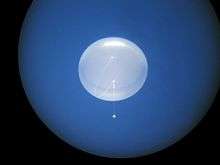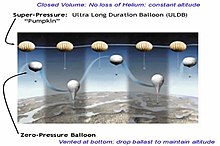Superpressure balloon
A superpressure balloon (SPB) is a style of aerostatic balloon where the volume of the balloon is kept relatively constant in the face of changes in ambient pressure outside the balloon, and the temperature of the contained lifting gas. This allows the balloon to keep a stable altitude for long periods. This is in contrast with much more common variable-volume balloons, which are either only partially filled with lifting gas, or made with more elastic materials. Also referred to as pumpkin or Ultra Long Distance Balloons (ULDB) balloons, the sealed balloon envelopes have a pumpkin shape at flight altitude. [1] In a variable-volume balloon, the volume of the lifting gas changes due to heating and cooling in the diurnal cycle. The cycle is magnified by a greenhouse effect inside the balloon, while the surrounding atmospheric gas is subject to a much more limited cyclical temperature change. As the lift gas heats and expands, the displacement of atmospheric gas increases, while the balloon weight remains constant. Its buoyancy increases, and this leads to a rise in altitude unless it is compensated by venting gas. Conversely, if the balloon cools and drops, it becomes necessary to release ballast. Since both ballast and gas are finite, there is a limit to how long a variable-volume balloon can compensate in order to stabilize its altitude. In contrast, a superpressure balloon will change altitude much less without compensation maneuvers.[2]


Since the volume of the balloon is more constrained, so is the volume of air displaced by it. In accordance with the Principle of Archimedes, the upwards force on the balloon is equal to the weight of the displaced ambient gas. But the weight of the atmospheric gas is reduced as the balloon rises, because its density diminishes with increasing altitude.[3] So the force pushing the balloon upwards diminishes with altitude and at some particular altitude, the upwards force will equal the weight of the balloon. As a result, the balloon will be stable in a finite equilibrium altitude range for long periods.
The disadvantage is that such balloons require much stronger materials than non-pressurized types.
Applications
Superpressure balloons (SPB) are typically used for extremely long duration flights of unmanned scientific experiments in the upper atmosphere,[2] where atmospheric gas temperature is quite stable through the diurnal cycle.[4] In 1985, such balloons were used for aerobots flying at an altitude of approximately 50 kilometres (160,000 ft) in the atmosphere of Venus, in the international, Soviet-led Vega program.
In February 1974, Colonel Thomas L. Gatch Jr, USAR attempted to make the first crossing of the Atlantic by balloon in a superpressure balloon named Light Heart. Following the loss of at least two of the ten balloons which provided lift, and after deviating substantially from the course that Colonel Gatch had plotted to take advantage of the jet stream, the last reported sighting of the Light Heart was 1,610 kilometres (1,000 mi) west of the Canary Islands; no further trace of the aircraft was ever found.[5]
.jpg)
In March 2015, NASA launched a SPB to an altitude of 110,000 feet (34,000 m) for 32 days from New Zealand and landed in Australia after a leak was detected.[6] This was the first time a SPB was flown for a long duration through the day and night cycle. When fully inflated, it was the size of a football stadium.
Google's Project Loon uses superpressure balloons to achieve flights of over 200 days.[7]
The SPB TRAVALB-2 surpassed previous Antarctic balloon flights by staying aloft for 149 Days, 3 hours, and 58 minutes after launch from the NASA Long Duration Balloon (LDB) site at LDB Camp, McMurdo Station, Antarctica. The operation was supported by National Science Foundation and United States Antarctic Program. [8] After the Travalb-1 launch abort, the Travalb-2 lifted off on 29 December 2019 to test NASA balloon trajectory predictions in Antarctica and to study electron loses from Earth's radiation belts. [9]
References
- "Scientific Balloons". NASA.gov. NASA. Retrieved 14 July 2020.
- "Successful Flight Of NASA Prototype Super-Pressure Balloon In Antarctica". space-travel.com. January 27, 2009.
- Shelquist, Richard (2010). "An Introduction to Air Density and Density Altitude Calculations". Shelquist Engineering.
- Seidel, Dian J.; Free, Melissa; Wang, Junhong (2005). "Diurnal cycle of upper-air temperature estimated from radiosondes" (PDF). Journal of Geophysical Research. American Geophysical Union. 110 (D9). doi:10.1029/2004JD005526.
- "Private flight: transatlantic balloon attempt". Flight International. IPC Transport Press Ltd. 105 (3390): 263. 1974. Retrieved 2011-06-30.
- Chirgwin, Richard (28 April 2015). "NASA 'UFO' pops a leak, lands in outback Australia: Super Pressure Balloon flight terminated, 32 days into planned 100-day flight". The Register.
- "LinkedIn: "Meet flight system P-496"". www.linkedin.com. Retrieved 2019-07-24.
- "NASA Long Duration Balloon (LDB) site at LDB Camp, McMurdo Station". csbf.nasa.gov. NASA. Retrieved 14 July 2020.
- "NASA campaign in Antarctica (IV)". stratocat.com. Stratocat.com. Retrieved 14 July 2020.
External links
- NASA Superpressure balloon
- NASA Image of the Day "Aloft" showing a superpressure balloon over Antarctica.
- Nott's Super-pressure balloon